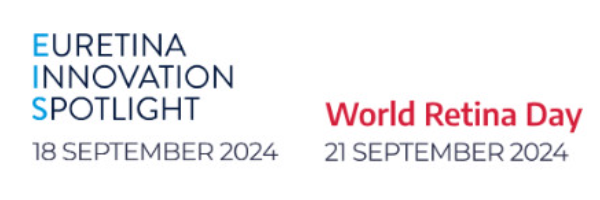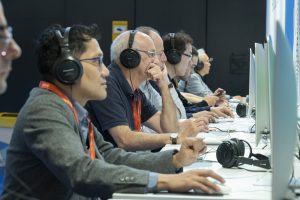It was not that long ago that advanced dry age-related macular degeneration (AMD) was receiving little attention as a target for therapeutic intervention. Evidence of a dramatic shift in this situation was demonstrated by the fact that non-neovascular AMD was a focus for two sessions at the 2024 Euretina Innovation Symposium.
The first session began with a discussion of two intravitreal treatments that are commercially available in the United States – pegcetocoplan (Apellis) and avacincaptad pegol (ACP, Astellas). Cedric Francois, MD, PhD from Apellis reviewed data from the premarketing studies investigating pegcetacoplan that showed its highly significant effect for slowing the growth of geographic atrophy (GA) lesions. He also presented microperimetry data showing that the size of GA lesions may be correlated with loss of retinal sensitivity, and reported that after 36 months of follow-up, the treatment demonstrated a nominally significant effect for decreasing progression to scotomatous blindspots.
Stating that not all complement inhibitors are created equal, Sharon Bakalash, MD, PhD, from Astellas talked about the features that distinguish avacincaptad pegol (ACP). She also reviewed efficacy data from clinical trials and reported that the efficacy and high safety profiles observed in clinical trials are consistent with what is being seen in real world data.
The next two speakers presented novel investigational treatments for GA. Tarek Hassan, MD, Aviceda Therapeutics, discussed AVD-104, a synthetic sialic acid-coated nanoparticle that binds siglecs. He said that AVD-104 is aiming to provide greater efficacy for reducing GA lesion growth, improved functional benefit and increased safety by inhibiting AMD inflammation via novel mechanisms, specifically targeting the over activated macrophages and microglia that damage the retina. Dr Hassan explained how this approach has the potential for healing AMD damage, reviewed positive results form a phase 2a study, and announced that a phase 2b trial that includes ACP as an active comparator is fully enrolled with results expected later in 2025.
ONL1204, a treatment that prevents Fas activation, was presented by David Zacks, MD, PhD, representing ONL Therapeutics. Explaining that this novel mechanism of action addresses both cell death and inflammation, Mr Zacks presented data from a phase 1b trial showing positive safety results and signals of efficacy. The results have supported launch of a phase 2 study that is being conducted in the US, Europe, and Canada.
During a panel discussion, questions to presenters from the audience and session moderators, Martin Zinkernagel, MD, PhD and Prof Frank Holz, MD, looked toward the future and explored the potential for achieving better outcomes with combination approaches.
“I believe that nobody thinks there is a single approach that would work better than others,” said Dr Hassan, acknowledging that pursuing the potential benefits of combination therapy is a worthwhile goal.
“This highlights the fact that there are many ways that we should be vigorously approaching this problem,” he said.
The presenters were also asked about the potential for treating GA with systemic therapy. This question was addressed by Dr Francois, who began his presentation with a discussion of systemic pegcetacoplan that is approved in the United States for the treatment of paroxysmal nocturnal hemoglobinuria. Dr Francois responded that the answer is not known, but he suggested that combining intravitreal and systemic complement inhibition or an approach that combines complement inhibition with an intervention working outside the complement system may be synergistic.
Finally, the presenters were asked about treatment that would prevent progression of intermediate AMD to late-stage disease, which Prof Holz described as the “holy grail” for treating AMD. While agreeing that early intervention is ideal, the ability to prove benefit can be an obstacle to product development, said Dr Zacks.
“The question is endpoints. How will we show in a reasonable time period that we are having a beneficial effect that is meaningful to patients long-term,” he stated.
























































































































